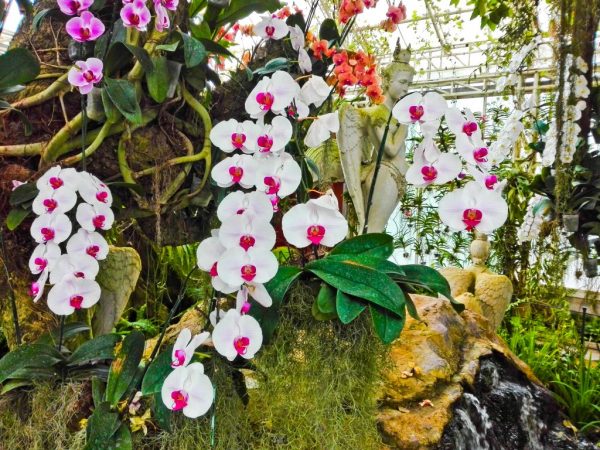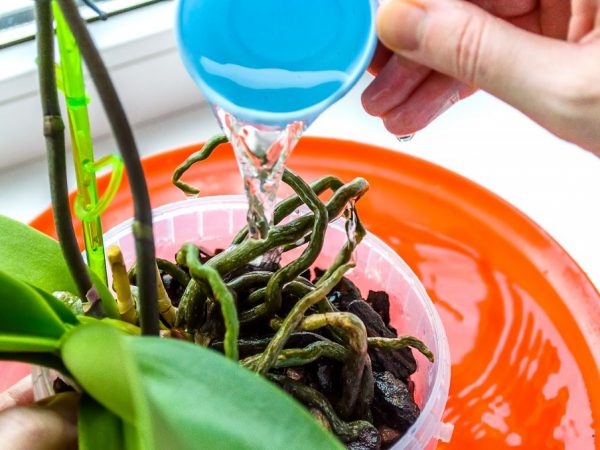Application of Bona forte for orchids
Bona forte for orchids is a concentrated fertilizing complex for prolonging the flowering stage of a plant.

Application of Bona forte for orchids
Varieties and chemical composition
Bona forte liquid fertilizer is presented to producers in 2 variants - "Beauty" and "Health".
The chemical composition of the "Beauty" series includes:
- macronutrients - 1.3% magnesium, 4% nitrogen, 2.5% phosphorus, 7.0% potassium,
- trace elements - molybdenum, iron, manganese, cobalt, boron, zinc, copper,
- vitamins - thiamine, C, niacin,
- ethane dicarboxylic or succinic acid.
The chemical composition of the "Health" series contains 0.5% of humic acid instead of succinic acid.
Purpose
In both fertilizing complexes, the main constituent element, nitrogen-phosphorus-potassium NPK, or azophoska, provides the plant with additional nutrition, magnesium activates the photosynthetic process in the leaves. In the “Beauty” series, succinic acid acts as a growth stimulant, and in the “Health” series, humic acid renews depleted substrates and preserves chemical substances in the soil for a long time, giving the orchid the opportunity to gradually receive them in the required amount.

In fertilizer complexes, the main constituent element is nitrogen-phosphorus-potassium NPK
Additional elements in the chelated form included in the composition of the chemical:
- provide complete and balanced nutrition, stimulating the active development of vegetative parts and roots,
- contribute to the complete assimilation of nutrients by the plant,
- strengthen resistance to disease in orchids,
- activates active flowering, accelerating onset time, providing intensity and increasing duration.
The tonic growth stimulant and plant health preparation are used for healthy flowers, the condition of which is not weakened by diseases and stresses as a result of transplantation.
Bona forte for orchids is used 1-2 weeks after the transplant procedure.
The use of Bona forte is not recommended for sick or damaged plant pests, with the exception of complex use with other drugs in treatment.
Scheme and processing methods
The use of fertilizing complexes, according to the instructions, is possible at different stages of plant development:
- At the stage of active growth from March to October. Liquid fertilizers "Beauty" and "Health" are applied at intervals of 1 week. This provides additional support at the developmental stage, therefore, a complex with succinic acid is often used.
- Dormant from November to February. The frequency of application is once a month. The limitation of the use of the complex is due to the absence of the need to stimulate the growth of the flower, therefore, the use of a liquid fertilizer containing humic acid is recommended.
Before direct application of Bona forte, it is imperative to moisturize the roots of the flower. This avoids burning the root system with the active substances of the drug.

You need to use fertilizing complexes according to the instructions.
According to the instructions, drugs are introduced by one of the possible methods:
- by the method of root feeding, for which 5 ml (1/8 of the cap from the bottle) of Bona forte is diluted in 1.5 liters of water. The flower is watered with the working liquid by the usual immersion method for 20 minutes,
- by foliar feeding, for which 5 ml of the drug is diluted in 3 liters of water and the leaves and roots of the plant are sprayed with the working liquid, avoiding moisture on the inflorescences and buds.
In order to avoid getting the leaves and roots of the flower root burns, adhere to the concentration of the working fluid specified in the instructions. The product is diluted with settled or filtered water at room temperature. Spray is used for spraying.
The series "Health" and "Beauty" alternate with an interval of 2-3 months after application.
Precautions
The ready-made working solution is valid for no longer than 14 days after preparation. The fertilizing complex does not lose its effectiveness after freezing.
The drug belongs to the 4th hazard class and requires compliance with basic hygiene rules during work: the use of protective gloves and hand washing.
Conclusion
Balanced fertilizer for Bona Forte orchids is essential for flower development. It provides abundant flowering and extends its duration up to six months by activating the process of photosynthesis with the help of its component magnesium and stimulating growth through the succinic acid it contains.


